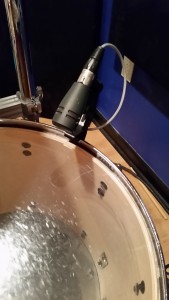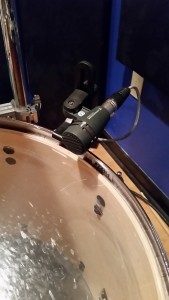Tom Mic Shootout Revisited
A few years ago, I blogged about a tom mic shootout that I conducted between two very popular mics for toms: the Sennheiser e604 and the CAD M179. At that time, I had been using the e604’s for recording my tom tracks and really wasn’t too thrilled with them. Meanwhile, I had been reading many positive reviews about what a great tom mic the CAD M179 made, so I ordered a pair to try them out.

In the course of that shootout, part of what I discovered was that you could get some very different sounds out of the e604’s by changing the positioning of the mics on the drums. When I positioned them in what I considered a fairly conventional way (a couple of inches above the head, pointing down toward the center of the head at an angle–see image above), I didn’t really like the sound of the tracks. However, when I positioned them closer to the tom head, almost parallel to the head and pointing across it (see image below), I liked the sounds of the tracks much better, and they sounded much more similar to the M179’s. After that shootout, I continued using the M179’s as my go-to tom mics for the next few years. Then, I started recording a hard rock/metal band with a particularly active drummer who often played a lot of fast and intricate parts on the toms, and things got more complicated.

First, his kit was set up very tightly, without much space at all between his toms and cymbals. Positioning an M179 on the floor tom was easy enough, but he had several cymbals that made it very difficult to position them on the mounted toms. I had to put them on some long mic boom stands and extend them out quite far. Due to the weight of the mics, I had trouble keeping the stands from tipping over during the session.
Second, the spill on the tom tracks was really bad, and made it very difficult to edit them. I normally edit my tom tracks to remove any silence and spill/bleed (other drums, cymbals, etc.), leaving behind only the actual hits on the toms. It was hard to edit the “tails” of the tom hits because the mics were picking up so much of the rest of the kit–particularly the decay of the crash cymbals.
On that first session with this band, I struggled with the M179’s for the reasons listed above. On the second session, I decided to try something different: I dusted off a couple of e604’s and used them on the mounted toms. At the time of my original shootout, I was using a different drum kit (Ludwig Classic Maple) in the studio, and the stock clips that came with the e604’s had not played nicely with the RIMS-style tom suspension mounts on those drums. But I had since changed over to a different drum kit (Tama Starclassic Birch) with a different type of suspension mount that allowed me to use the stock e604 rim clips, rotate the mics 90 degrees to one side or the other, and put them right where I wanted: very close, with the mic’s body almost parallel to the head, with the mic pointing across the head instead of pointing down at it from an angle. So for the second session with this band, I was able to clip the mics directly to the rims of the toms, which made positioning a breeze. When the session was over, editing the tom tracks was also much easier. The spill wasn’t bad at all with the e604’s.
Now, back to the M179’s. I still think these are stellar mics. After all, I’ve recorded some really outstanding acoustic guitar & tom tracks with them, but they just didn’t make an ideal tom mic for every recording situation. I had to find another use for them, so I decided to try them out as overhead mics on the drum kit. For the next session, I set them up in a typical AB position, checked to be sure they were equidistant from the snare, and let me tell you, I REALLY liked the sound of those overhead tracks–particularly when I put the M179’s in Omni mode. They picked up a really beefy sound that I wasn’t accustomed to hearing. They also picked up a nice, full-bodied crack from the snare. In fact, as I listened back to those overhead tracks, I could almost imagine getting away with using ONLY the M179’s as overheads and maybe a close mic on the kick for some sessions.
I also discovered something very interesting about the M179’s: they handle transients better than any other condenser mic I’ve used. In fact, they handled the transients so well, the recorded tracks looked almost like they had already been compressed! This is a stark contrast to the normal peaks in the waveforms (with the occasional harder hit on the snare) that I see with the small diaphragm condensers that I’ve often used in the past. This better handling of transients could allow one to push the overhead tracks a little higher in a mix without them peaking out too high, giving a nice, roomy sound to the kit.
So here I am a few years down the road, and I’ve come full circle on tom mics: I’m back to using the e604’s. And in the process I’ve found a new favorite overhead mic: the M179. If you own one or both of these mics, give these suggestions a try. If you don’t own them and are in the market for tom or overhead mics, you should definitely add them to your short list of models to consider. They both bring something nice to the table when it comes to recording drums.
Items mentioned in this post:
Sennheiser e604 Dynamic Drum Mic
CAD M179 Condenser Mic
Ludwig Classic Maple Drums
Tama Starclassic Birch Drums
 August 15, 2017
|
Posted by Jon (admin)
August 15, 2017
|
Posted by Jon (admin)
 Categories:
Categories:  Tags:
Tags: 